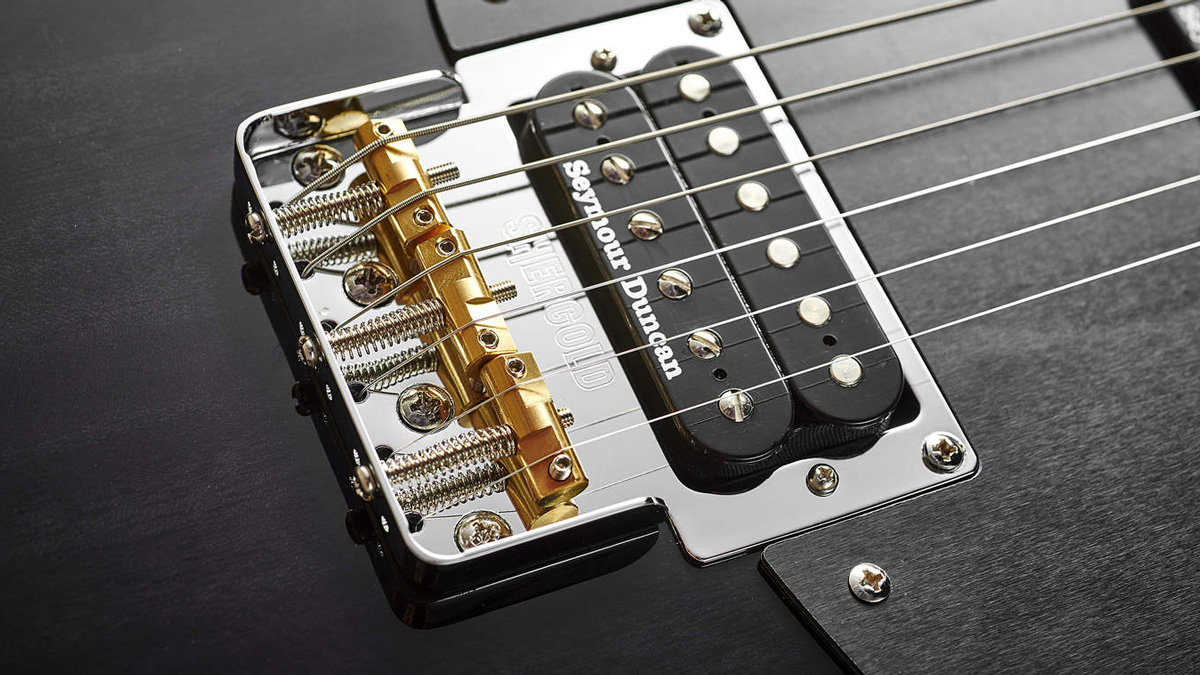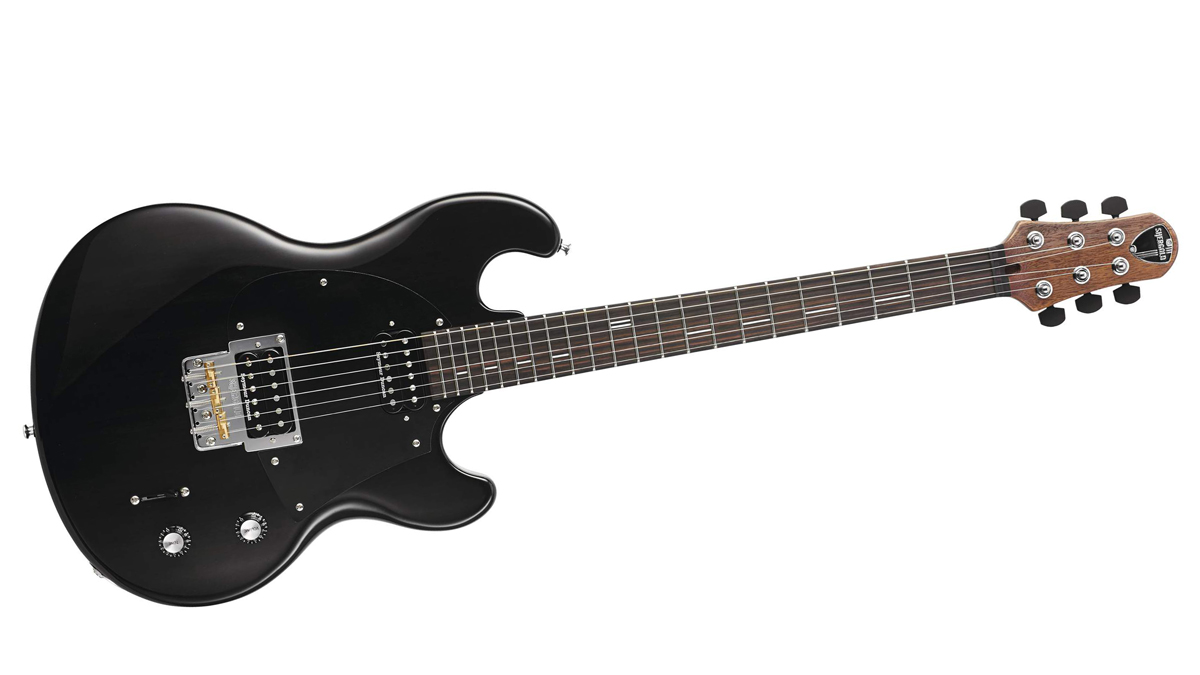MusicRadar Verdict
An affordable and well-built guitar that is well worth your time.
Pros
- +
Affordable boutique vibe.
- +
Great build.
- +
Simple to control versatile rock.
Cons
- -
No gigbag.
- -
Body outline isn’t for everyone.
MusicRadar's got your back
Talk about timing. British distributor Barnes and Mullins, the company behind Faith guitars, re-launched Shergold at the start of this year.
The result of a lengthy project headed up by Brit luthier Patrick James Eggle, the three new Masqueraders all boasted solid rosewood necks and fingerboards - a very boutique-y, high-end feature on guitars that retailed comfortably under £1,000.
Little did they know that the guitar making industry would be turned on its head by the CITES restrictions on importing and exporting rosewood. Though it hasn’t banned the use of the classic fingerboard wood it has led to many companies offering alternatives.
When we spoke to Patrick at the NAMM show earlier this year he hinted that they might have to generate a non-rosewood model, and here it is: the Masquerader 4, which retains the same basic design but swaps that rosewood neck for more conventional mahogany and adds an ebony fingerboard.
“Yes it is a CITES buster, for the moment,” says Patrick. “Who knows what’s going to happen with the ebony situation,” he adds in reference to the varied rumours that CITES might well turn their attention to ebony in the not too distant future.
“So, yes, the restrictions on rosewood was clearly what brought about this model initially: we thought we’re going to need something that we can ship without any issues. That said, we’re over the issues really; we’ve done the relevant paperwork but we needed to look at alternatives immediately. We looked at maple and roasted maple for the necks, then we looked at mahogany, which, with the existing mahogany body, made it more single-cut inspired: a real rocker.”
The original trio of Masqueraders primarily differed with their pickup compliments. All Seymour Duncan, the 1 offers a humbucker/P-90 pairing, the 2 goes for a hum/single/single set-up, while the 3 offers three single-coils, the bridge pickup placed Tele-style. Two classic formats are clearly missing: three single coils (with vibrato?) and two humbuckers. So, along with side-stepping that rosewood issue, the new 4 aims to fill that latter gap by offering dual ‘buckers – Duncan’s classic JB at bridge (like the 1 and 2) and a ’59 at neck.
While the dual ‘bucker configuration also creates the most original Shergold-alike style yet the aim here wasn’t to reissue a guitar from yesteryear but bring the brand into the 21st century. So, like the original trio, the 4 retains a sort of boutique vibe that is very workmanlike rather than over-blinged ‘art’.
Certainly in its see-through black transparent gloss - albeit the sole colour offered here, unlike the other models - it actually looks like a deep, dark brown rather than an inky black but it gives a moody and serious vibe with the striped dark browns of the fingerboard and the true black of the scratchplate all tying in nicely. It looks the part and its now all-mahogany construction, not least with the rock-ready JB, smacks of classic rock-era tonal inspiration.

Yes, we get numerous subtle twists like the relieved heel area, which reduces the bulk; very nice forearm and rib-cage contours; the troublesome-to-source Bakelite scratchplate (which could do with a little rounding of its rather too sharp edges); those individualistic aluminium line inlays; Japanese turned aluminium strap buttons that are classy, if a little small; and like the original trio it’s all put together with style and panache, as you’d expect from the PJE stable.
Feel and Sounds
This sample is a little weightier than the previous ones we reviewed but weighs bang on a near perfect 3.6kg. The neck continues the fit-for-purpose rock vibe and measures 21.9mm at the 1st fret, 24mm by the 12th.
“We tried a beefy late-50s neck profile but it didn’t really gel with the instrument so we’ve kept the profile the same, which is still quite beefy,” adds Patrick. It is quite big, in a good way, and has a beautifully burnished sheen - it’s not matt, not gloss, more like a true satin. There’s generous depth but slightly tapered shoulders, which avoids it feeling over clubby.
There’s certainly an inviting ringing and resonant acoustic response, not as darkly voiced as the construction might suggest. From what we’re hearing that Tele-style thru strung bridge seems to be certainly doing its job with the added sparkle of the Fender scale and, perhaps a soupçon of clarity from the ebony ‘board. Patrick agrees, saying: “Interestingly, I think there’s a little more ‘zing’ here; rosewood is quite dark sounding but it’s [the 4] still got the depth to the sound; I think it sounds pretty graunchy and quite classic.”
Amp’d up, the classic ‘bucker combo sounds pretty familiar but they can only translate what the guitar is producing and the edgy acoustic character emerges to provide a clarity to the JB that we don’t always hear, with a nice string separation, too. It’s typically pokey and while not quite producing the thickness of a single-cut, blends the grunt and grind with that crispness.
Pulling the volume back retains the clarity and cleans up the voice, especially in the mixed position on the 3-way lever while the neck pickup aptly illustrates why the ’59 is so popular: a lower powered, flute-y drive that not only adds depth and texture to the mix but makes for a perfectly good classic lead voice.
The addition of simultaneous coil-splits - voicing the inner slug coils - takes this Masquerader into a much more Fender-y territory that might not exactly capture the character of a Telecaster but provides more than usable tonal shift on this platform. Both the volume (with a 0.001 microfarad cap and a 150k ohm resistor - in parallel - treble bleed circuit) and tone pots are nicely graduated; the 0.047 microfarad tone cap might seem a bit excessive but you can’t fault the gradual to full-woof roll-off.
However, its ‘secret weapon’ is that split JB which still kicks out approximately 8.3k ohms from its slug coil. It makes for a pretty juicy power ‘Strat’ tone with less edge than the real thing, not least due to its non-angled placement and the fact that the slugs sit much further from the saddles (approx 48mm).
It loses the ‘rock’ from the full-coiled JB and wiring the coil-split switch to just have the JB split would be something we’d consider, especially as the neck split does sound a little thin and stringy on its own. The wiring itself is very tidy and there’s plenty of air in the over- sized control cavity so any DIY wiring mods would be a pleasant experience. As ever, you choose.
Thinking of these revitalised Shergolds as some kind of reissue severely misses the point - it’s more accurate to consider them as offshore and highly affordable versions of the guitars made by Patrick James Eggle here in the UK. They ooze boutique vibe but it’s far from on the surface only. Yes, the outline might be a little divisive - though we have to say it’s grown on us, particularly in this colour - but here’s a guitar, not least in this classic ‘bucker combination, that’s got ‘gig me’ stamped all over it, with great feel, great playability and enough versatility to cover most of your gigs. We didn’t miss the rosewood either and might suggest this is the best so far of a very good bunch.
Dave Burrluck is one of the world’s most experienced guitar journalists, who started writing back in the '80s for International Musician and Recording World, co-founded The Guitar Magazine and has been the Gear Reviews Editor of Guitarist magazine for the past two decades. Along the way, Dave has been the sole author of The PRS Guitar Book and The Player's Guide to Guitar Maintenance as well as contributing to numerous other books on the electric guitar. Dave is an active gigging and recording musician and still finds time to make, repair and mod guitars, not least for Guitarist’s The Mod Squad.
“I actually specifically remember making a deal with myself": Billie Eilish reveals what she had to do in order to become “looser and jazzier” with her vocal delivery
“These guitars travel around the world and they need to be road ready”: Jackson gives Misha Mansoor’s Juggernaut a new lick of paint, an ebony fingerboard and upgrades to stainless steel frets in signature model refresh
“I’m surprised and saddened anyone would have an issue with my performance that night”: Zak Starkey explains why he got fired from The Who











